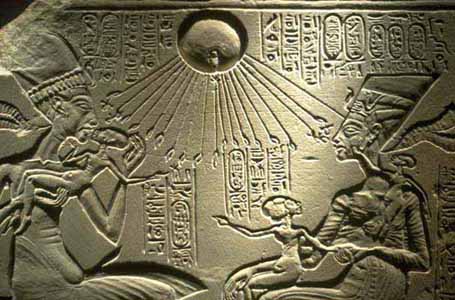
This shrine stela also from the early part of the Amarna period depicts Akhenaten, Nefertiti, and Princesses Meretaten, Mekeaten, and Ankhesenpaaten worshiping the Aten as a family. Dorothea Arnold in her article "Aspects of the Royal Female Image during the Amarna Period" discusses the plethora of reliefs depicting intimate family moments. While Akhenaten leans forward to give Meretaten a kiss, Mekeaten plays on her mother's lap and gazes up lovingly.
At the same time Ankhesenpaaten, the smallest, sits on Nefertiti's shoulder and fiddles with her earring. Arnold claims that the shrine stela "relates to the Aten religion's concept of creation" in which the King and Queen are viewed as "a primeval 'first pair." At the top of the composition, the sun-god, Aten, represented by a raised circle, extends his life-giving rays to the Royal Family. The relief uses the concept of the "window of appearances" or a snapshot of life. The figures are framed by a fictive structure which suggests the form of a square window. Aldred in his book Egyptian Art calls this "a brief moment in the lives of five beings as they are caught in an act of mutual affection". In actuality, the royal palace at Akhetaten had a window from which the royal couple could observe the city and address their subjects.
It is accepted that Akhenaten and Nefertiti had six daughters. No son was ever shown in reliefs.
The names of the daughters were; Meritaten (1349 BC) - Meketaten and Ankhenspaaten (1346 BC) - Neferneferuaten (1339 BC) - Neferneferure and Setepenre (1338).
In 1337 BC the official family, with all six of Nefertiti's daughters was shown for the last time.
In 1336 BC Meketaten died in childbirth.
In 1335 Nefertiti seemed to vanish, assumed dead.


